In modern construction, soil waterproofing is often carried out, which is necessary to protect the bases of any structures from the effects of liquid. A set of special measures for the hydrophobic treatment of buildings, as well as the use of waterproof devices and materials, allows you to protect the foundation, floor, or walls of the structure from contact with the liquid contained in the soil, and also significantly prolongs the service life of the building.
Competently organized work on waterproofing the soil will ensure the integrity of a country house or an apartment building, regardless of what level of groundwater is characteristic of a particular area, as well as how deep their freezing is. This article will be discussed what materials this process is carried out, as well as what mandatory steps the soil waterproofing technology includes.
When and why it is necessary to do waterproofing on the ground
Waterproofing of buildings on the ground is necessary for reliable protection of the entire structure or its individual elements from the effects of moisture of various origins: precipitation, thawed and groundwater, capillary moisture, and other phenomena.
Such treatment of structures is carried out at the stage of construction of cellars or basements when arranging floors on the ground and in some other cases. Waterproofing on the ground with the use of hydrophobic primers and other waterproof materials will help protect the structure from such unpleasant phenomena as increased humidity on the premises, the formation of damp areas, the growth of fungus, and mold, as well as the occurrence of flooding and leaks.
As a rule, floors on the ground are mounted in small country houses, the main elements of which are made of wood. In addition, the waterproofing in question prevents the penetration of moisture into the premises and thereby protects the load-bearing elements of the structure from destruction.

Types of waterproofing materials and their installation technology
Currently, soil waterproofing is applied using a wide variety of materials. It is important that the compositions can tolerate constant contact with the liquid and at the same time not be destroyed. Such hydrophobic materials, as a rule, do not have the ability to withstand the effects of ultraviolet radiation, but at the same time, they are subject to fairly high requirements regarding operational characteristics.
The choice of a suitable hydrophobic composition is based on the type of construction, physical and chemical properties of the soil, groundwater level, and other indicators. At the same time, it is recommended to supplement the waterproofing on the ground with a drainage system that will drain excess fluid from the suburban area or from the house territory.
Moreover, the type and complexity of waterproofing may depend on which part of the building requires hydrophobic treatment.
Let’s consider the most common compositions with which soil waterproofing is carried out, in more detail.
Membranes
Protective membranes intended for waterproofing on the ground are made on the basis of a high-density polyurethane. From the outside, membrane slabs are equipped with special protrusions, perforation areas, and other irregularities designed to connect slabs or strips of material with each other. The membrane is usually laid with an overlap, so the individual waterproofing elements are connected to each other by means of a lock fixation. The membrane is characterized by high resistance to the most aggressive environmental factors.
Among them are harmful or even toxic chemicals contained in the soil and in groundwater, precipitation, minerals, and capillary moisture, as well as some other particularly dangerous effects. The waterproofing membrane creates an air gap between the hydrophobic material itself and the foundation surface. Such a layer ensures the dryness of the premises and does not allow the liquid concentrated in the ground to damage the load-bearing elements of the structure.
You can read more about membrane waterproofing in the article – “Membrane waterproofing: Types of materials and methods of their arrangement“.
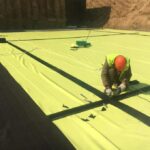

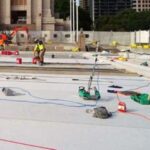


Waterproofing of the soil with a film
Hydrophobic films are considered a kind of flat type membranes, and they are necessarily laid on the treated surface in several layers. Waterproofing films are most often based on polyurethane of high or low strength, polyolefin, or polyvinyl chloride (PVC).
The high-quality composition and compliance with all the rules of laying the material help to achieve its useful properties such as water resistance, excellent durability, and long service life, during which the films do not lose their operational properties. In addition, films are characterized by an acceptable cost, due to which they are used for a huge number of types of work.

Roll waterproofing
Roll-type materials are traditionally used for the hydrophobic treatment of most structural elements, as well as for waterproofing on the ground. Transportation and storage of such compositions do not require financial or time costs, and even not the most experienced builder can cope with laying strips of hydrophobic composition on the work surface.
A few decades ago, the assortment of rolled materials was represented only by roofing material made on the basis of building cardboard. Today, in hardware stores, you can also buy rubemast and pergamine (based on cardboard), polyester (based on polyester resins), fiberglass, or glass-fiber mat. The latter material is the composition that is most resistant to aggressive environmental factors.
You can read more about roll waterproofing in the article – “Roll waterproofing arrangement with detailed installation instructions“.
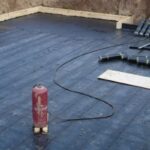
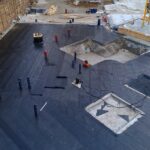
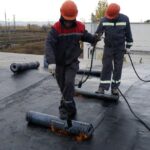
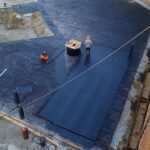
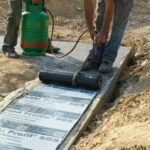
Penetrating materials
Materials of the penetrating type or penetrating compositions belong to the coating waterproofing. Such materials are supposed for deep penetration into the pores and voids of the concrete base. Most often, penetrating compounds are used for waterproofing concrete surfaces.
To date, the most popular manufacturer of penetrating compounds is considered to be the company “HYDRO” whose assortment includes a variety of hydrophobic primers, as well as dry mixtures that are prepared immediately before use. At the same time, it is extremely important to observe the proportions of the liquid and dry components at the stage of mixing the solution. The use of penetrating waterproofing compounds allows to an increase in the operational properties of concrete and resistance of the material to various external influences.
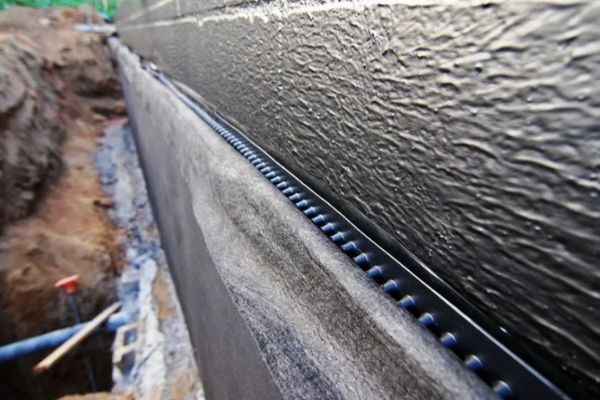
Liquid rubber
Currently, liquid rubber is considered as one of the highest quality waterproofing materials. It is relatively easy to work with, and it also has excellent operational properties. Such material is distributed over the work surface using special sprayers, for working with which it is necessary to have some experience. Therefore, the application of liquid rubber on the base is most often done by professionals.
The service life of liquid rubber, regardless of what atmospheric influences it is exposed to, is more than 35-45 years. The repair of the hydrophobic coating is carried out by applying an additional layer of material to the damaged area. After applying liquid rubber, a very strong elastic coating is formed on the surface, which is not damaged and is not cracked even with seasonal shrinkage of the structure.
The probability of cracks and other defects in the rubber coating is rapidly approaching to zero. And such a property of liquid rubber as the ability to penetrate into the deepest and most remote areas of the surface, compensating for 99% of the defects of the base, make it such a waterproofing material that it is difficult to compare with other compounds in terms of useful properties.
You can read more about liquid rubber in the article – “Waterproofing with liquid rubber“.


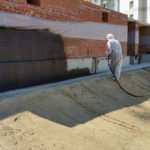

Waterproofing of the floor on the ground: How to do the work correctly so that there are no leaks later
As you know, concrete— is a porous structure that absorbs water and moisture and passes it without proper protection. When in a basement, socle or other room it is necessary to erect a concrete floor on the ground base and to do this so that ground water or moisture in the ground does not get through the concrete floor into the future room, then it is necessary to follow the following waterproofing technology:
- Ramming the base from the ground;
- Laying of the separation layer of geotextile;
- The arrangement of a sandy base from 10-30 sm with its careful ramming;
- Laying of the separation layer of geotextile;
- The arrangement of a concrete screed, taking into account its reinforcement with a metal mesh—is a so-called concrete base, which will serve as a rigid base for the subsequent installation of waterproofing which will separate the concrete floor slab from moisture and water rising from the ground;
- Installation of fillets (a small skirting board) of Sand-cement screed at the junction of the transition from the horizontal base to the vertical — this should be done so that the future waterproofing rises smoothly from the horizon to the vertical since the transition made in 90 degrees will be a violation and a weak point in the waterproofing coating;
- Waterproofing arrangement, which should go along the horizontal base of the concrete screed and rise to the walls by at least 30 sm;
- Laying of the separation layer of geotextile;
- Binding of the reinforced frame for future filling of the main floor slab;
- Installation of a swelling cord or bentonite profile at the joints of the future slab or walls, to protect the future cold seam;
- Pouring concrete with the addition of special hydrophobic additives.
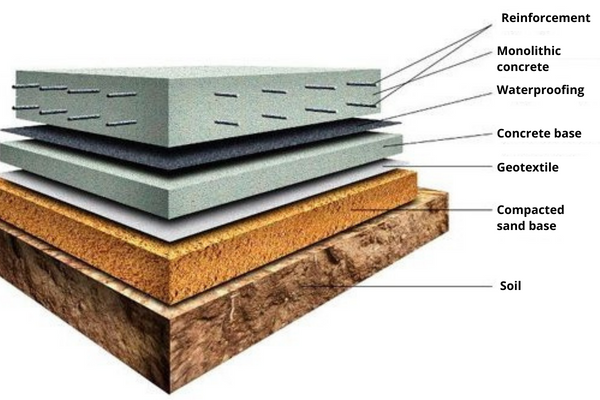
Important: The ground base has mobility and dynamics, that is why almost any waterproofing base laid on it in the future will simply disperse at the seams and joints, since it will be subject not only to the aggressive effects of salts and minerals contained in the ground water, but also to the constant movement of the base. It is for this reason that before installing waterproofing, it is necessary to make a concrete screed on the ground, which will serve as a rigid and reliable basis for the future waterproofing layer.
You can read more about the technology of the concrete basement floor and the methods of its waterproofing in the following articles:
- Waterproofing of the basement floor of the house: Methods, technologies of the arrangement, and materials
- How to make properly a basement recess below the sole of the foundation
Waterproofing of the underground on the ground
Waterproofing on the ground is carried out in many cases, for example, when arranging floors in buildings or at the construction stage of the foundation of an apartment building. This process is carried out using the technique of film waterproofing flooring or by forming “clay locks” which is especially important for waterproofing underground on the ground.
When carrying out work on waterproofing the underground on the ground, it is important to pay attention to the following steps:
- The preparation of the soil, that is its ramming, is carried out. This process is preceded by leveling the soil using an optical or laser-type leveling device.
- Often, the compaction of the soil is supplemented by filling an additional layer of sand (mainly coarse). The sand is also compacted, and the thickness of its final layer should vary from 7 to 10 centimeters.
- In cases where waterproofing on the ground is primarily aimed at protecting the structure from the effects of capillary moisture, filling with crushed stone is also used. However, it is worth noting that this technique is suitable for working only with dry soils that are not saturated with groundwater. The crushed stone distributed on the surface is necessarily compacted in such a way that the thickness of its layer does not exceed 10 centimeters.
- The next stage — is the filling of the rough screed implies the distribution of the material over a layer of crushed stone pre-treated with bitumen. Most often, sand-cement mortar is used as a screed material, which forms a reliable basis for installing other types of waterproofing. The thickness of the rough screed may not exceed 5 centimeters, and height differences of more than 3 mm per 2 meters of the surface are not allowed.
- Installation of a rough screed, as a rule, involves further laying of waterproofing materials of rolled or other types. Rolled materials are laid out on the base with an overlap of 10 centimeters.
Important: The ground base has mobility and dynamics, that is why almost any waterproofing base laid on it in the future will simply disperse at the seams and joints, since it will be subject not only to the aggressive effects of salts and minerals contained in the ground water, but also in the constant movement of the base. It is for this reason that before installing waterproofing, it is necessary to make a concrete screed on the ground, which will serve as a rigid and reliable basis for the future waterproofing layer.
Prices for waterproofing arrangement
| Description of work | Unit of measurement | Price in $ |
| The arrangement of surfaced waterproofing on the horizon | m2 | starting from 36 |
| The arrangement of surfaced waterproofing on the vertical | m2 | starting from 49 |
| Arrangement of a self-adhesive membrane on the horizon | m2 | starting from 35 |
| The arrangement of a self-adhesive membrane on a vertical | m2 | starting from 48 |
| The arrangement of PVC membrane on the horizon | m2 | starting from 58 |
| The arrangement of PVC membrane on the vertical | m2 | starting from 68 |
| Application of polyurea | m2 | starting from 90 |
| Application of mastic waterproofing | m2 | starting from 20 |
| Application of liquid rubber by spraying | m2 | starting from 25 |
| Application of liquid rubber manually | m2 | starting from 33 |
| Application of cement-mineral double-component waterproofing | m2 | starting from 60 |
| Arrangement of polyurethane waterproofing | m2 | starting from 60 |
| Application of penetrating compounds | m2 | starting from 60 |
| Application of primer | m2 | starting from 10 |









